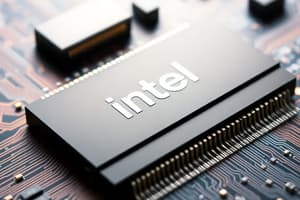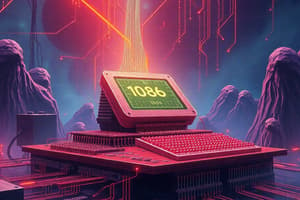Podcast
Questions and Answers
What is the default segment register for program (code) in Intel microprocessors?
What is the default segment register for program (code) in Intel microprocessors?
- SS
- DS
- ES
- CS (correct)
In 80386 and above microprocessors, which register is used as the program counter?
In 80386 and above microprocessors, which register is used as the program counter?
- ESP
- EIP (correct)
- IP
- EBP
Which segment register is used for stack operations in Intel microprocessors?
Which segment register is used for stack operations in Intel microprocessors?
- ES
- CS
- SS (correct)
- DS
What is the offset address associated with the program counter in 8080, 8086, and 80286 microprocessors?
What is the offset address associated with the program counter in 8080, 8086, and 80286 microprocessors?
Which segment register is used for string (destination) data in Intel microprocessors?
Which segment register is used for string (destination) data in Intel microprocessors?
What is the purpose of the VM flag?
What is the purpose of the VM flag?
What is the purpose of the DS segment register in Intel microprocessors?
What is the purpose of the DS segment register in Intel microprocessors?
What is the function of the ID flag?
What is the function of the ID flag?
What is the purpose of the CS register?
What is the purpose of the CS register?
What is the purpose of the AC flag?
What is the purpose of the AC flag?
What is the size of a segment in real mode?
What is the size of a segment in real mode?
What is the purpose of the FS and GS registers?
What is the purpose of the FS and GS registers?
What is the primary function of the program-visible registers in a microprocessor?
What is the primary function of the program-visible registers in a microprocessor?
What is the purpose of the flag bits in the Flags register?
What is the purpose of the flag bits in the Flags register?
What is the difference between memory addressing in real mode and protected mode?
What is the difference between memory addressing in real mode and protected mode?
What is the purpose of the processor (organization) model?
What is the purpose of the processor (organization) model?
What is the main difference between program-visible registers and program-invisible registers?
What is the main difference between program-visible registers and program-invisible registers?
What is the purpose of the memory paging mechanism?
What is the purpose of the memory paging mechanism?
What is the evolution of the 80X86 architecture?
What is the evolution of the 80X86 architecture?
What is the architecture of a microprocessor?
What is the architecture of a microprocessor?
What is the purpose of the prefetch-&-queue scheme?
What is the purpose of the prefetch-&-queue scheme?
What is the term for fetching the next instruction while the current instruction is being executed?
What is the term for fetching the next instruction while the current instruction is being executed?
What is the result of BIU adding the offset of 4214H in IP to the segment base address 348A0H?
What is the result of BIU adding the offset of 4214H in IP to the segment base address 348A0H?
What is stored in the CS register?
What is stored in the CS register?
What is the purpose of the direction flag (D) in the 8086 processor?
What is the purpose of the direction flag (D) in the 8086 processor?
What is the alternative way of representing a 20-bit physical address?
What is the alternative way of representing a 20-bit physical address?
What is stored in the IP register?
What is stored in the IP register?
What is the purpose of the interrupt flag (I) in the 8086 processor?
What is the purpose of the interrupt flag (I) in the 8086 processor?
What is the role of the IP register in producing the physical address of the next instruction?
What is the role of the IP register in producing the physical address of the next instruction?
How is the physical address of the next instruction produced?
How is the physical address of the next instruction produced?
What is the result of BIU automatically inserting zeros for the lowest 4 bits of the segment base address?
What is the result of BIU automatically inserting zeros for the lowest 4 bits of the segment base address?
What is the purpose of the sign flag (S) in the 8086 processor?
What is the purpose of the sign flag (S) in the 8086 processor?
What is the reason for not adding the two 16-bit numbers directly in line to produce the physical address?
What is the reason for not adding the two 16-bit numbers directly in line to produce the physical address?
What is the purpose of the auxiliary flag (A) in the 8086 processor?
What is the purpose of the auxiliary flag (A) in the 8086 processor?
What is the purpose of the BIU?
What is the purpose of the BIU?
What is the purpose of the trap flag (T) in the 8086 processor?
What is the purpose of the trap flag (T) in the 8086 processor?
Flashcards are hidden until you start studying
Study Notes
The Microprocessor and its Architecture
- A microprocessor (MP) is a programmable digital device designed with registers, flip-flops, and timing circuits.
- The MP has a set of instructions to manipulate data and communicate with peripherals, determined by its architecture.
Internal Architecture of the Microprocessor
- The programmer's model, also known as the registers model, is one aspect of the internal architecture.
- The processor (organization) model is another aspect of the internal architecture.
Memory Addressing
- Memory addressing can be done using segmentation in both real mode and protected mode.
- In real mode, memory addressing is done using a 20-bit physical address.
- In protected mode, memory addressing is done using a 32-bit physical address.
Instruction Pointer (IP)
- The IP register holds a 16-bit offset/address of the next code byte within the current code segment.
- The value in IP is referred to as an offset because it must be added to the segment base register in CS to produce a 20-bit physical address.
- The CS register contains the upper 16 bits of the base address of the current code segment.
EFLAGS (Flags Register)
- The Flags register contains status flags that are set or reset based on the outcome of arithmetic and logical operations.
- Basic flag bits include Carry (C), Parity (P), Auxiliary (A), Zero (Z), Sign (S), Overflow (O), and Direction (D).
- Newer flag bits include IOPL, NT, RF, VM, AC, VIF, VIP, and ID.
Segment Registers
- Each segment register points to the start of a segment in memory.
- Segment registers are CS (code), DS (data), ES (extra data), SS (stack), FS, and GS (on 80386 and above).
- Segment registers define the start of a section (segment) of memory for a program, which can be either 64K bytes of fixed length (real mode) or up to 4G bytes of variable length (protected mode).
Defaults
- Default segment numbers are assigned to CS for program (code), SS for stack, DS for data, and ES for string (destination) data.
- Default offset addresses are associated with each segment register.
Studying That Suits You
Use AI to generate personalized quizzes and flashcards to suit your learning preferences.




